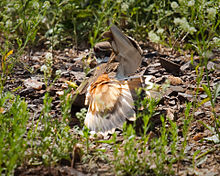
Distraction displays, also known as diversionary displays, or paratrepsis[1][2] are anti-predator behaviors used to attract the attention of an enemy away from something, typically the nest or young, that is being protected by a parent.[3][4] Distraction displays are sometimes classified more generically under "nest protection behaviors" along with aggressive displays such as mobbing.[5] These displays have been studied most extensively in bird species,[1] but also have been documented in populations of stickleback fish[6][7][8][9][10] and in some mammal species.[11][12]
Distraction displays frequently take the form of injury-feigning.[4] However, animals may also imitate the behavior of a small rodent or alternative prey item for the predator;[13][14][15] imitate young[12] or nesting behaviors such as brooding (to cause confusion as to the true location of the nest),[13] mimic foraging behaviors away from the nest,[9] or simply draw attention to oneself.[1]
- ^ a b c Armstrong, Edward (1949). "Diversionary display.--Part 2. The nature and origin of distraction display". Ibis. 91 (2): 179–188. doi:10.1111/j.1474-919X.1949.tb02261.x.
- ^ Armstrong, Edward (1949). "Diversionary display.--Part 1. Connotation and terminology". Ibis. 91 (1): 88–97. doi:10.1111/j.1474-919X.1949.tb02239.x.
- ^ Barrows, Edward M. (2001) Animal behavior desk reference. CRC Press. 2nd ed. p. 177 ISBN 0-8493-2005-4
- ^ a b Armstrong, Edward (1954). "The ecology of distraction display". British Journal of Animal Behaviour. 2 (4): 121–135. doi:10.1016/S0950-5601(54)80001-3.
- ^ Caro, Tim (2005). "Nest defense". Antipredator Defenses in Birds and Mammals. Chicago, IL: The University of Chicago Press. pp. 335–379.
- ^ Ruxton, Graeme D; Thomas N. Sherratt; Michael Patrick Speed. (2004) Avoiding attack: the evolutionary ecology of crypsis, warning signals and mimicry. Oxford University Press. ISBN 0-19-852859-0. p. 198
- ^ Foster, Susan (1988). "Diversionary displays of paternal stickleback: Defenses against cannibalistic groups". Behavioral Ecology and Sociobiology. 22 (5): 335–340. doi:10.1007/BF00295102. S2CID 35942608.
- ^ Ridgway, Mark; McPhail, John (1987). "Raiding shoal size and a distraction display in male sticklebacks (Gasterosteus)". Canadian Journal of Zoology. 66 (1): 201–205. doi:10.1139/z88-028.
- ^ a b Whoriskey, Frederick (1991). "Stickleback distraction displays: Sexual or foraging deception against egg cannibalism?". Animal Behaviour. 41 (6): 989–995. doi:10.1016/S0003-3472(05)80637-2. S2CID 53193441.
- ^ Whoriskey, Frederick; FitzGerald, Gerard (1985). "Sex, cannibalism and sticklebacks". Behavioral Ecology and Sociobiology. 18 (1): 15–18. doi:10.1007/BF00299233. JSTOR 4599857. S2CID 21522305.
- ^ Cite error: The named reference
:2was invoked but never defined (see the help page). - ^ a b Cite error: The named reference
:3was invoked but never defined (see the help page). - ^ a b Cite error: The named reference
:4was invoked but never defined (see the help page). - ^ Cite error: The named reference
:5was invoked but never defined (see the help page). - ^ Cite error: The named reference
:6was invoked but never defined (see the help page).
© MMXXIII Rich X Search. We shall prevail. All rights reserved. Rich X Search
